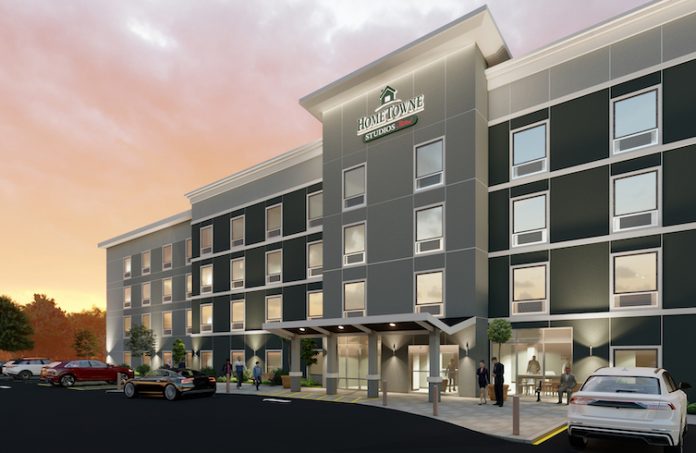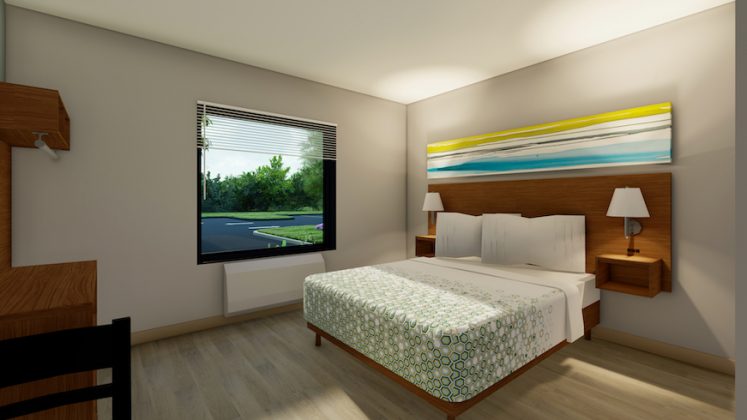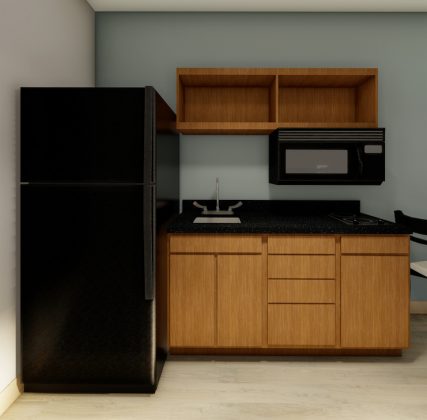Today at the annual Asian American Hotel Owners Association Convention (AAHOACON 2021), Red Roof unveiled a new prototype for its HomeTowne Studios by Red Roof brand. The brand marked the company’s entry into the extended-stay segment when it launched in August 2018, and has since grown to 58 properties totaling more than 7,000 rooms nationwide. As Red Roof Interim President George Limbert shared with LODGING, the company aims to grow that footprint five-fold over the next several years, attracting developers with its new efficient prototype designed with input from owners, longtime franchisees, and guests. LODGING sat down with Limbert ahead of AAHOACON 2021 to discuss plans for the new HomeTowne Studios prototype and how Red Roof is positioning the brand for success.
What went into developing this new prototype for HomeTowne Studios? How did the pandemic impact the design?
We wanted to make the new prototype more efficient from an operations perspective while still guest friendly and guest efficient, so we sat down with our operators. The number-one issue we are hearing right now is the labor shortage, and COVID did play a role in moving us toward a more labor-friendly model; you can operate a HomeTowne Studios with six employees.
To make this prototype one that could be efficiently run and operated was a huge piece of our puzzle for the brand, but it needed to be done in a way that didn’t take away from the guest experience. We thought about what long-term guests want. For example, often extended-stay guests who are living at the hotel have a lot more than just a suitcase, so efficient storage spaces are important to them. There’s no box spring so guests can store underneath the bed, and we added a lot more open cubbies throughout the room to make it more attractive and appealing to guests while also removing unnecessary cabinets that guests don’t use, making it more efficient for housekeepers to clean.
What type of traveler are you aiming to attract with this brand?
Every market needs an economy, extended-stay hotel. We’re trying to capture economy nomads: Those who can work remotely from anywhere, including from our hotel. We also think that there’s an opportunity to manage the long-term guests who are looking for the amenities, but not necessarily the stringency of having an apartment lease. You can stay for six months in an extended-stay hotel without having to sign a lease. You can leave early if your job takes you somewhere else or if you have to move for personal reasons; for instance, to take care of an elderly parent.
What about on the development side: How are you positioning to grow this brand?
We’re looking at two areas of growth from the development side. The economy, extended-stay market is really attractive to institutional investors, so we’ve been talking to development firms that may have been doing apartments traditionally and are interested in and see the value in extended-stay hotels. And then, of course, our Red Roof Inn franchisees, who we really think will take advantage of opening and building the HomeTowne Studios by Red Roof hotels.
Are there specific markets that you’re looking to get into?
With the new prototype, we can do both conversions and new builds, but we see the most growth coming from new construction. Right now, we have franchisees developing five new-construction HomeTowne Studios in the Florida market. We’ve been looking at the Ohio market, which is where our headquarters are, and talking to some development groups about new construction in the Columbus market. We’ve also been looking at Texas. My personal goal is to put 300 new construction HomeTowne Studios in the ground over the next five to seven years.
How is Red Roof’s portfolio as a whole performing? What is your outlook for the year ahead?
Red Roof Inn hotels are doing better than they did in 2019, attracting leisure travelers and road warriors who have been traveling all summer. We have concerns about the Delta variant. We have concerns about business travel coming back in the fall. For us, college sports coming back in full steam is really important—that’s a huge driver of our fall revenues. We’re a resilient brand—the economy segment, in general, performed better than others during the pandemic. We’ll be able to weather any kind of storm, but we’re really hoping for a strong fall.













